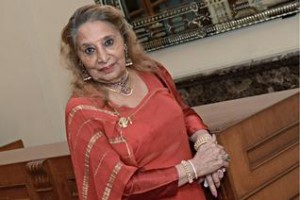Ranee Vijaya Kuttaiah talks about the intense relationship of her Kodava community with food, her quest for recipes across two States, and reveals secrets of the early years of food styling in India

Avid golfer. Kalakshetra student. Bharatanatyam and Kathakali dancer. Great grandmother. Lived the good life in the Nilgiris. Travelled the world giving performances. Anjaneya bhakt. Ford Motors PR in New York. Writer. Food stylist. Lecturer. Hotel manager. A very good cook.
Ranee Vijaya Kuttaiah is so many things rolled into one, it’s difficult to keep pace with this energetic Kodava matriarch as she flits from one story of her life to another. She can hold forth on anything from how politics is dirty to why prostitution should be legalised. And from how to boil lobster just so, to how to make ice cream that won’t melt under bright lights. All this coming from a woman who, when she got married, didn’t know how to make a cup of tea.
“I used to write for The Hindu when I lived in the Nilgiris with my husband. I’m a Kalakshetra dancer. My husband died when he was young. I was just too heart broken and swore never to wear my anklets and dance again. I started writing short stories, started a company called Shadow Light Co-ordinators and we would do high-end food and fashion shoots in Bangalore,” says Ranee, of the beginnings of how she came to write about food.
ITC Windsor and Sterling Paperbacks re-launched a revised edition of her famous recipe book, Cuisine from Karnataka with her other classic Cuisine from Coorg this week at an evening that saw the who’s who of Coorg and Ranee’s friends bond over food and wine. Talking of the strong bond that her Kodava community has with food, she points out: “We worship our ancestors with liquor! On any occasion, we first offer a little bit of whatever we cook in front of the photos of our ancestors. We are a kshatriya race used to good food, and we are big agriculturists.”
While studying for her masters in the United States in the 1960s, during her summer break she chanced upon a food styling course in one of the hotels. She signed up for it and a whole unknown world was revealed to her. “Cooked food doesn’t style well. It creates a mess. Food is best shot uncooked. I’ll tell you a secret. You can’t photograph steam. So when I had to shoot a hot, steaming kettle, I would blow out smoke from a cigarette just in time for the photographer to shoot. Mind you I don’t smoke. Ice-cream melts under lights. So we would whip paint and freeze it to look like ice cream! I would par-boil lobsters and then paint them with lovely orange oil paints before setting it up on a silver platter.” When she styled food for the famous Sangeeta Khanna cookbook, her present publisher appreciatively ate a meal in her house and asked her to write a book on Coorg cuisine. Ranee turned to her mother for the classic recipes of Coorg. It’s a book that’s been going into reprint for the last 14 years.
One book led to another. Having lived 30 years in Tamil Nadu and having performed all over the State, she recalls taking down recipes whenever she travelled in Madurai, Ramnad, Thirunelveli and Thanjavur, recording recipes of Nadar and Thevar cuisine, which featured in her book Cuisine from Tamil Nadu. Her own personal favourite, though, is Syrian Christian non-vegetarian food from Kerala, she pipes in.
She decided to write about Karnataka cuisine because — “it’s my State and largely ignored” she says, with a mix of pride and hurt. “It’s was as if holige and bisi bele bhath were the only things Karnataka had to offer,” she says talking of the limited popularity of food from the state then. She had close friends in political circles like Ramakrishna Hegde. “Many of the ministers were Lingayats and Gowdas. I would travel to Mandya and Maddur, visit the homes of the Gram Panchayat chiefs and ask their wives what they cook at home. I would collect four to five recipes from different families of the same dish, come home and try them in my kitchen and arrive at what I thought was the best of them.” Her book on Karnataka covers food from the Lingayat, Gowda, Bunt, and Madhwa Brahmin community (into which her sister was married).
source: http://www.thehindu.com / The Hindu / Home> Features> MetroPlus / by Bhumika. K / October 17th, 2014

